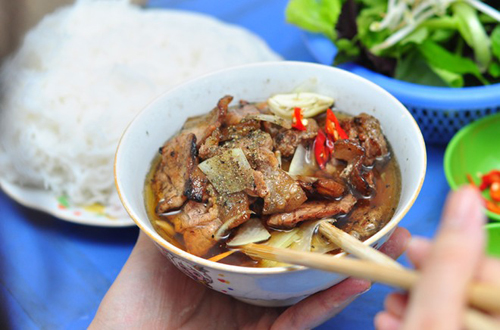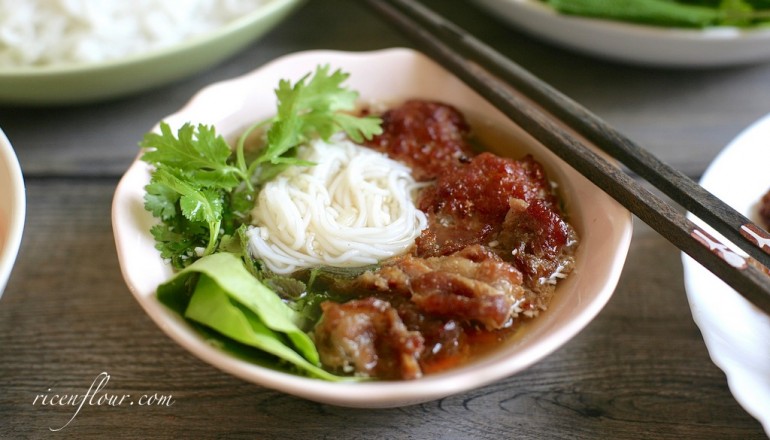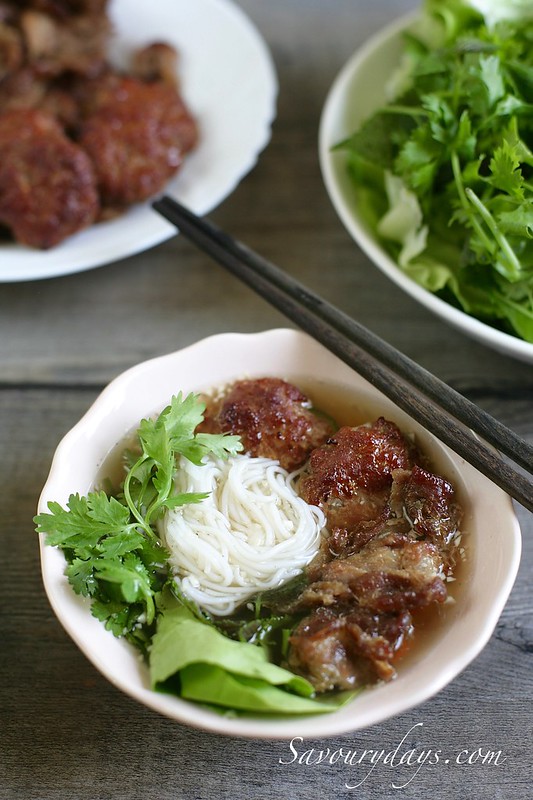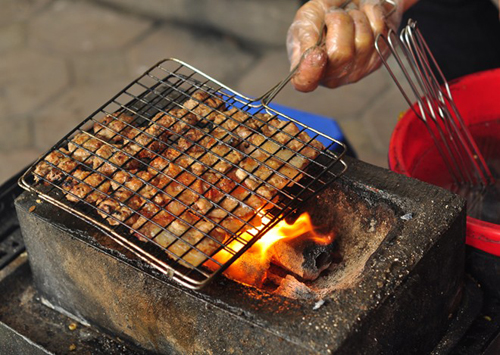I feel like upon speaking about Vietnamese food and rice noodles, everyone would mention ‘phở’. But the world of Vietnamese culinary culture offers us so much more ways of devouring many types of different noodles (do check out our glossary to read further on different types of noodles available in Vietnam). If ‘phở’ is known for a bowl of flat rice noodles with beef or chicken broth, ‘bún chả’ is round rice noodles served with a bowl of dipping sauce with grilled pork, pickles and greens. If you have been following the news of President Obama’s trip in Vietnam, you must have seen ‘Obama eating bún chả’ – and this is exactly the recipe you need to recreate one of the most iconic street food dishes in Hanoi.
Eating Bún chả at a street vendor in Hanoi

Photo from: http://thieunien.vn/55-an/7610-bun-cha-nong-thu-qua-nuc-mui-ngay-dong.html
There’s a saying that Vietnamese eat with all our senses. And trust me, you will understand this if you are to sit down at a bún chả street stall during busy lunch hour. First, you can already smell the mouth-watering grilled pork patties and pork belly approaching the stall. Then, you can hear the sizzling meat, the occasional ‘pop’ when the melting fat hits the coal. The sound of people coming and going on motorbikes, shouting orders and chattering and slurping creates a unique ambience of Hanoi’s street food stalls. A lady (usually) would put in front of you a plate of pearly white rice vermicelli, a basket with all sorts of greens, a bowl of dipping sauce with some sliced pickled carrots and green papaya, and of course, those beautifully charred pork pieces. Grab a pair of chopsticks and take some rice vermicelli noodles to dip into the sauce. A perfect bite consists of a bit of noodles, a piece of pork and a slice of pickles; all well soaked. As soon as the bite hits your tongue, you will taste how perfectly balanced in sweetness and sourness that dipping sauce is, how the noodles wonderfully complements it, how crunchy and tangy the pickles cut through the fatty pork and how the marinated pork just melts in your mouth.
Although originally a street food specialty, to me there is nothing that can beat my mom’s homemade bún chả. On a weekend that was quite special, she would get a small charcoal stove and grill the meat in the small patio in front of our house, and the whole street would be filled with a mouth-watering smell. I would, as a child, cheekily sneak a hot piece of meat freshly out of the stove, and that would always be the best piece of the whole batch. The pork marinade and the dipping sauce in this recipe is adopted from my family favourite, and I hope that it will soon become your favourite as well !
HOW TO MAKE BUN CHA (RECIPE)
(GRILLED PORK, RICE VERMICELLI NOODLES IN SWEET & SOUR DIPPING SAUCE)
INGREDIENTS
A. Vietnamese Caramel Sauce
- 70 grams (5 tbsp) sugar
- 150 ml (1/2 C + 2 tbsp) hot water
B. Grilled Pork
- 450 grams (1 lb.) pork shoulder or pork belly (choose a fatty piece to prevent the meat from drying out while being grilled)
- 450 grams (1 lb.) minced pork (similarly, choose minced pork with at least 10% fat)
- 50 grams shallots (about 6 – 8 shallots)
- 15 grams garlic (3 – 5 cloves)
- Fish sauce
- Oyster sauce
C. Side Pickles
- 400 grams green papaya, carrots, kohlrabi
- 25 grams (2 tbsp) sugar
- 15 ml (1 tbsp) rice vinegar or lemon juice
- ¾ tsp salt
- Fresh herbs to serve: coriander, perilla, lettuce, Vietnamese balm, …
D. Dipping sauce and Noodles
Dipping sauce (nước chấm in Vietnamese) is an essential condiment in Vietnamese cuisine, and usually consists of fish sauce, sugar, lime juice/lemon juice/rice vinegar, water and minced garlic and chilli to taste. My preferred ratio for a perfect nước chấm bún chả is 1 sugar : 2/3 acid : 1 fish sauce : 7 water.
- 25 grams (1.5 tbsp) sugar
- 15 – 18 ml (1 tbsp) lemon juice/rice vinegar
- 175 ml (3/4 cup) water
- 15 – 20 ml (1 – 1.5 tbsp) fish sauce
- Garlic, chilli, black pepper – to taste
- 1.5 kg fresh rice vermicelli noodles or 0.5 kg dried rice vermicelli noodles
INSTRUCTIONS
A detailed recipe with all the specific notes is available on Savoury Days’ YouTube Channel (subscribe to get all the newly uploaded recipes) in both English and Vietnamese. Check it out at this link or the video right below. Don’t forget to turn on HD setting for best quality.
The steps are quite simple and straightforward in the video. In short, the whole procedure of making bun cha can be summarised in five main steps as follows:
- marinating the meat
- making the pickles and the dipping sauce
- grilling the meat
- cooking dried vermicelli noodles
- serve
Therefore, in stead of listing the major steps of the method as usual, in the following section, I will note down some key points that will help you make the best and most authentic bún chả.
A. Picking the Cut, Marinating and Grilling the Meat:
– It is best to choose a fatty cut of pork, either pork belly or pork shoulder, to prevent the meat from drying while being grilled. I prefer pork shoulder because it is relatively leaner than pork belly, and the melted pork shoulder fat has a crunchy texture and savoury buttery flavour – which is rather fun to devour.
– There are two types of grilled meat in a traditional bún chả: grilled pork patties (chả băm) and grilled pork slices (chả miếng). Grilled pork patties are what distinguish bún chả (from Hanoi) from bún thịt nướng (from Central and Southern Vietnam), both of which consist of rice vermicelli noodles served with grilled pork.
– Another difference between the two regional dishes is that the pork marinade in bún chả does not have lemongrass, sesame seeds or sesame oil like the one in bún thịt nướng (if you would like to know how to make the grilled pork for bún thịt nướng, check out this previous recipe of mine). This is because Hanoi – situated in the North of Vietnam – has a milder tropical climate than the Central and Southern region, and therefore lemongrass – a tropical plant – is not a common ingredient in Hanoi’s culinary culture.
– Vietnamese caramel sauce (nước màu) is NOT like the sweet caramel sauce served with desserts, but is rather used as a food colouring to give the meat in savoury dishes a golden brown colour. It is really easy to make – simply boil sugar and water together. However, you can substitute Vietnamese caramel sauce with golden syrup or honey, or even the homemade golden syrup leftover from making mooncakes! The sugar content in all of the above will caramelise while you grill the meat, giving the pork not only a scrumptious chargrilled colour but also a smoky sweet caramel-like flavour. Just note that if you are using honey, the meat will burn more easily (since honey has a ‘purer’ sugar content than cooked caramel sauce or golden syrup), therefore, keep an eye on your grill pan.
– The pork is best grilled over charcoal fire – charcoal grilled pork has a far superior smoky flavour to oven grilled one. If you are using the oven, put the meat over a wired rack or a pizza pan – surfaces that allow the meat itself to be exposed to the heat from the top and the bottom. This will prevent the pork from being too dry, the grilled meat will be more tender as the heat is distributed evenly throughout.
Grilling bun cha’s pork over charcoal fire – the traditional & best way of making bun cha
Photo from: http://thieunien.vn/55-an/7610-bun-cha-nong-thu-qua-nuc-mui-ngay-dong.html
B. Pickles and Vegetables:
– Vietnamese cuisine is known as one of the healthiest in the world. Almost all Vietnamese dishes have vegetables, especially meaty and fatty dishes, to balance out the flavours, textures as well as the nutrients. You will easily find pickles and an abundant amount of fresh herbs and vegetables being served with many Vietnamese traditional dishes, and they usually come free with your meal in the restaurant by the way.
– Pickles in bún chả (and many other dishes such as bún thịt nướng, or bánh xèo – crispy Vietnamese pancakes) are usually made of thinly sliced green papayas and carrots. Cucumbers or kohlrabies are also great substitute for green papayas, and the contrast between the green and the bright orange colour of the pickles makes your dish more eye-catching and appealing.
– Pickles are also made fresh rather than preserved for a long time. When you make the fresh pickles, it is important to add sugar first rather than salt, as it will help the pickles be more crunchy. Adding salt will immediately draw out the moisture from the vegetables and make them a bit tough to chew.
C. Boiling the Rice Vermicelli:
– If you have fresh rice vermicelli – perfect. You just need to poach it through hot water just before serving, so that the rice vermicelli will soften and soak up the dipping sauce better.
– If you don’t live in Vietnam or near a big Asian market, it is more likely that you will end up with dried rice vermicelli. Although some packages say that the noodles can be soaked in hot water before serving, I find that the noodles do not expand properly even after being soaked for a long time, and thus would prefer to boil them in a pot of hot water. You can also poach the noodles through hot water again just before serving.
D. Making nước chấm – dipping sauce:
– The salt content of fish sauce varies from different types, so there is no fixed ratio to make nước chấm.
– What I would recommend is to mix sugar, lemon juice and water together first, taste it to make sure you are happy with the lemon juice. Then, gradually add fish sauce to taste. Tasting as you go along rather than dumping all the ingredients in at once will help you identify easily which flavour component (sweet, sour, savoury, …) is lacking.
– When added into nước chấm, the garlic (and chilli) should float on the surface – it looks more visually appealing rather than chunks of garlics sinking at the bottom. Here are a few tips to achieve this:
- Mince the garlic very finely, but don’t crush it. The dipping sauce should be warm when you add in the garlic.
- Soak the garlic in a little bit of vinegar and sugar before adding it into the dipping sauce.
- Recipe by: Linh Trang
- Written & Edited by: Thảo Đan






I used the dipping sauce and pickling recipe and both were delish! I highly recommend it!